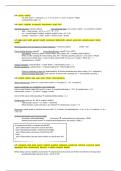Summary
Summary Introduction to R programming in Biology
- Course
- Institution
This exam sheet contains all the codes needed for the exam Introduction to R programming in Biology. This sheet will help you to receive a high exam grade. Good luck!
[Show more]



